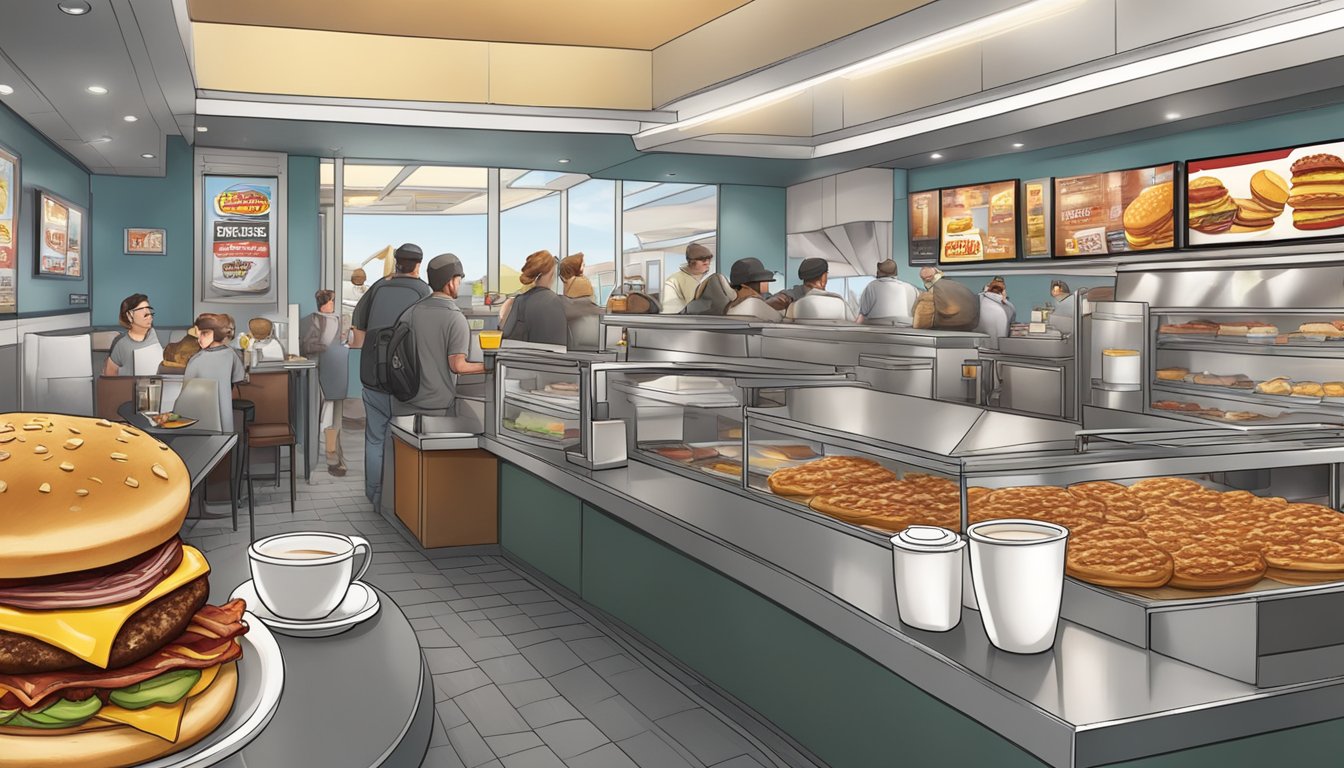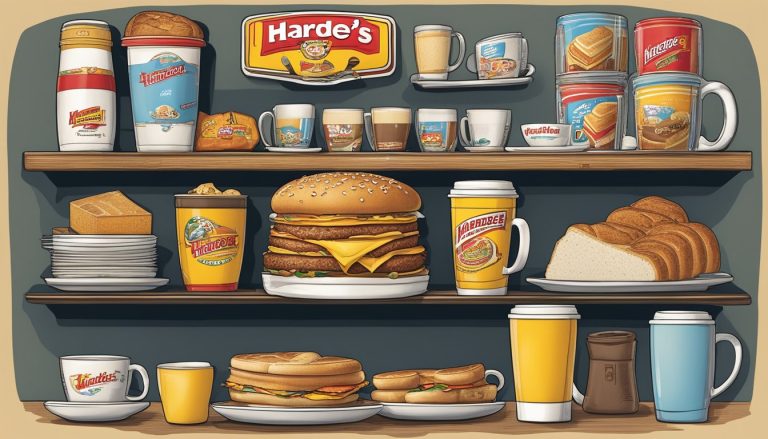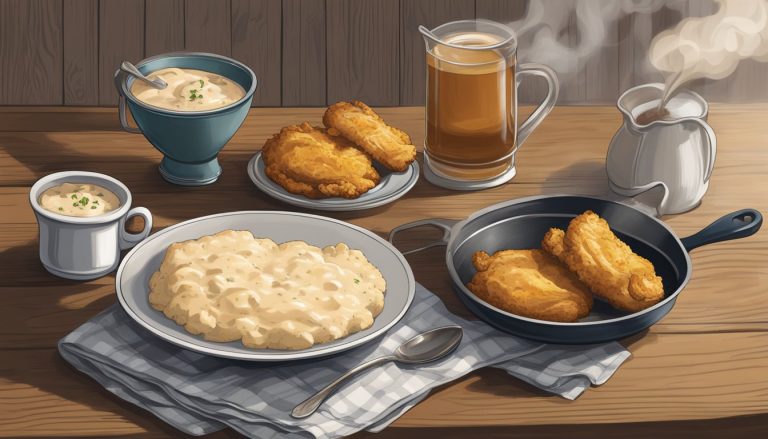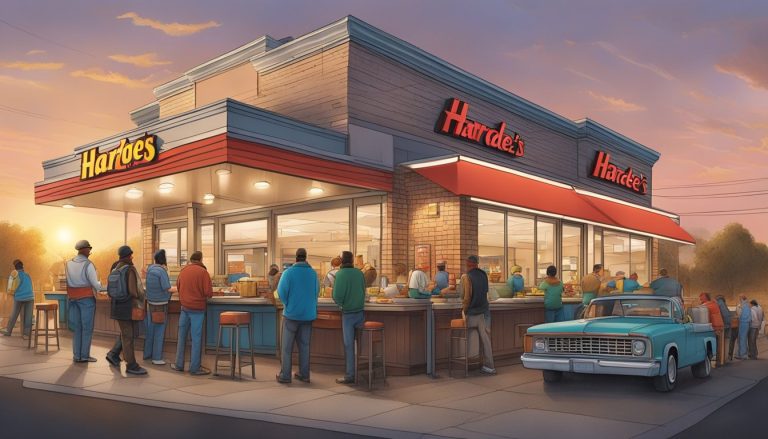Hardee’s and Carl’s Jr. may share a parent company, but their breakfast menus tell different stories. These fast-food giants cater to distinct regional tastes across the United States. Hardee’s offers a more extensive breakfast selection, featuring 10 different biscuit sandwiches, while Carl’s Jr. keeps it simple with just three options.
The breakfast divide between these chains reflects their unique histories and target markets. Hardee’s, with its roots in the South, embraces hearty, biscuit-based meals. Carl’s Jr., born in California, maintains a leaner menu aligned with West Coast preferences.
This contrast in breakfast offerings provides insight into how national chains adapt to local palates. It also highlights the delicate balance between maintaining brand identity and meeting regional demands. The tale of these two menus offers a fascinating glimpse into the strategies behind fast-food success in America.
Origin Story and Founding Fathers

Carl’s Jr. and Hardee’s trace their roots to two ambitious entrepreneurs who turned small starts into fast food empires. Their stories exemplify the American dream of building successful businesses from humble beginnings.
Carl Karcher’s Journey from Hot Dog Cart to Empire
Carl Karcher launched his food service career in 1941 with a single hot dog cart in Los Angeles. Using $311 in savings and a loan against his car, Karcher and his wife Margaret began selling hot dogs, chili dogs, and tamales. The cart’s success led to rapid expansion. By 1945, they owned four more carts.
Karcher opened his first full-service restaurant, Carl’s Drive-In Barbecue, in 1956. This paved the way for the first Carl’s Jr. restaurant in 1956, featuring a simplified menu and quick service. The iconic yellow star logo debuted in 1941, becoming a recognizable symbol of the growing chain.
Wilbur Hardee and the Roots of Hardee’s
Wilbur Hardee founded his eponymous restaurant in Greenville, North Carolina, in 1960. The first Hardee’s featured a limited menu centered around 15-cent charcoal-grilled burgers, fries, and milkshakes. Hardee’s innovative char-grilled burgers set it apart from competitors.
The restaurant’s success prompted rapid expansion through franchising. By 1963, there were 32 Hardee’s locations across the Southeastern United States. Hardee sold his stake in the company in 1963 but left an enduring legacy.
CKE Restaurants acquired Hardee’s in 1997, merging it with Carl’s Jr. while maintaining separate brand identities in different regions. This merger created one of the largest fast food chains in the United States.
Brand Evolution and Identity

Hardee’s and Carl’s Jr. have undergone significant transformations in their branding and identity over the decades. Their journeys intertwine through corporate acquisitions and marketing shifts, shaping two distinct yet related fast food powerhouses.
Merging Paths: Hardee’s and Carl’s Jr. under CKE
CKE Restaurants acquired Hardee’s in 1997 for $327 million, uniting it with Carl’s Jr. This merger created a fast food giant with over 3,000 locations. The two chains maintained separate identities in different regions, with Hardee’s dominating the Southeast and Midwest while Carl’s Jr. remained strong in the West.
CKE implemented a strategy to align the menus and marketing of both brands. They introduced Carl’s Jr.’s famous charbroiled burgers to Hardee’s locations, enhancing menu consistency across the combined chain.
The Role of Branding and Americana in Expansion
Both Hardee’s and Carl’s Jr. have leveraged Americana themes in their branding to appeal to a wide audience. Carl’s Jr. started as a hot dog cart in Los Angeles in 1941, embodying the American dream of entrepreneurial success.
Hardee’s, founded in North Carolina in 1960, built its reputation on Southern-style biscuits and hospitality. The brands embraced bold, eye-catching advertising campaigns to stand out in the competitive fast food landscape.
In 2018, Hardee’s and Carl’s Jr. launched separate marketing campaigns to highlight their distinct identities. This move allowed each brand to cater more specifically to regional tastes and preferences.
Understanding the Happy Star Logo
The iconic “Happy Star” logo has been a cornerstone of both brands’ visual identity. Originally created for Carl’s Jr., the smiling star became a shared symbol after the merger with Hardee’s.
The Happy Star underwent several redesigns over the years, maintaining its cheerful essence while adapting to modern design trends. Its simplicity and recognizability have made it an effective branding tool across various media platforms.
In recent years, the logo has been used differently by each chain, with Carl’s Jr. featuring a more prominent star and Hardee’s incorporating it into a shield design. This subtle differentiation helps maintain the brands’ individual identities while preserving their shared heritage.
Menu Offerings: A Comparative Overview
Hardee’s and Carl’s Jr. present distinct menu offerings reflecting their regional roots and customer preferences. Both chains showcase a variety of burgers, sandwiches, and breakfast items, but with notable differences in their signature dishes and regional specialties.
Signature Dishes and Fan Favorites
Hardee’s is renowned for its Made from Scratch Biscuits and hearty breakfast options. The chain’s menu features Thickburgers, hand-breaded chicken tenders, and biscuits and gravy. Carl’s Jr., on the other hand, is famous for its charbroiled burgers, particularly the Western Bacon Cheeseburger.
Both chains offer similar burger lineups, including Angus beef options. Carl’s Jr. stands out with its Guacamole Bacon Angus Cheeseburger and Jalapeño Angus Cheeseburger, catering to West Coast tastes.
Side dishes vary between the chains. Carl’s Jr. offers unique items like fried zucchini and onion rings, while Hardee’s focuses on classic options such as waffle fries.
Vegetarian and Vegan Options: Beyond Meat Integration
Both Hardee’s and Carl’s Jr. have embraced plant-based alternatives, partnering with Beyond Meat to offer vegetarian and vegan-friendly options. Carl’s Jr. introduced the Beyond Famous Star with Cheese, a plant-based version of their signature burger.
Hardee’s followed suit with its own Beyond Meat offerings, including breakfast items. This move has expanded menu choices for vegetarians and vegans at both chains.
The integration of Beyond Meat products demonstrates the chains’ adaptability to changing consumer preferences and dietary requirements.
Regional Dishes and Appeal to Local Tastes
Hardee’s and Carl’s Jr. maintain distinct regional identities through their menu offerings. Hardee’s, prevalent in the East and Midwest, focuses on comfort food and heartier breakfast options. Their extensive biscuit sandwich menu caters to Southern tastes.
Carl’s Jr., dominant in the West, incorporates more Mexican-inspired flavors. The Green Burrito concept, found in many Carl’s Jr. locations, offers items like breakfast burritos, tacos, and quesadillas.
Regional menu variations reflect local preferences. For instance, Carl’s Jr. locations may feature more spicy options and California-influenced dishes, while Hardee’s emphasizes traditional American fare.
Cultural Impact and Marketing Campaigns

Carl’s Jr. and Hardee’s have leveraged celebrity power and regional pride to create memorable advertising campaigns. These efforts have solidified their place in American fast food culture and helped distinguish the two brands.
Celebrity Endorsements and the Voice of Matthew McConaughey
Carl’s Jr. made waves with its “Call of Carl’s” campaign, featuring the distinctive voice of Matthew McConaughey. The actor’s Texas drawl added a touch of star power to the brand’s marketing efforts.
The campaign promoted Carl’s Jr.’s iconic Western Bacon Cheeseburger, tapping into the “crave culture” phenomenon. This celebrity endorsement strategy aimed to elevate the brand’s image and appeal to a wider audience.
Carl’s Jr. has a history of using celebrities in its ads, creating buzz and reinforcing its bold image. These campaigns have often sparked conversations and kept the brand in the public eye.
Local Ties: Featuring Real People and Southern Accents
Hardee’s has taken a different approach, focusing on its southern roots and connection to local communities. The brand’s “Tastes Like America” campaign showcased real people and authentic southern accents.
This strategy aimed to highlight Hardee’s pride in its regional heritage. By featuring everyday customers and employees, the ads created a sense of relatability and authenticity.
Country music often features in Hardee’s commercials, further reinforcing its southern identity. This approach helps differentiate Hardee’s from Carl’s Jr. and appeals to its core customer base in the southeastern United States.
The “Feed Your Happy” campaign reunited Carl’s Jr. and Hardee’s under a single marketing umbrella. This effort sought to balance the brands’ shared identity with their distinct regional flavors.
The Breakfast Battle: Hardee’s vs. Carl’s Jr.
Hardee’s and Carl’s Jr. offer distinct breakfast experiences, with unique menu items and operating hours. Their morning offerings cater to different tastes and preferences across regions.
Exploring Breakfast Menus: Biscuit Showdown
Hardee’s takes pride in its made-from-scratch biscuits, a cornerstone of their breakfast menu. These fluffy creations serve as the foundation for various biscuit sandwiches, including classics like sausage, egg, and cheese.
Carl’s Jr., while offering biscuit options, places more emphasis on their breakfast burrito selection. Their menu features hearty options like the Monster Biscuit, packed with eggs, bacon, sausage, and cheese.
Both chains offer unique breakfast platters. Hardee’s Loaded Breakfast Burrito and Carl’s Jr.’s Breakfast Burger showcase each brand’s distinctive approach to morning meals.
The Early Bird Special: Drive-Thru and Opening Hours
Hardee’s typically starts serving breakfast earlier, often opening at 5:30 AM in many locations. This early start caters to customers seeking a quick meal before work.
Carl’s Jr. usually begins breakfast service slightly later, around 6:00 AM. However, both chains extend their breakfast hours until late morning, accommodating late risers.
Drive-thru service is a key component for both restaurants. Hardee’s and Carl’s Jr. prioritize efficient service, aiming to minimize wait times during the morning rush.
Menu availability may vary by location, with some restaurants offering all-day breakfast options to meet customer demand.
Demographics and Market Penetration

Carl’s Jr. and Hardee’s target distinct regional audiences across the United States. Their market strategies focus on appealing to specific demographics and urban areas, tailoring their offerings to local tastes and preferences.
Target Audience: Regional Audiences and Urban Areas
Carl’s Jr. concentrates its efforts on the Western United States, particularly in California and other urban centers. The chain appeals to a younger, more diverse demographic with bolder flavors and innovative menu items. Its marketing often targets millennials and Gen Z consumers in bustling city environments.
Hardee’s, on the other hand, maintains a strong presence in the Midwest and Southern states. The brand caters to a more traditional, family-oriented customer base in suburban and rural areas. Hardee’s menu features heartier options that resonate with its core audience.
Both fast-food chains adapt their marketing and product offerings to suit their respective target markets. Carl’s Jr. emphasizes its California roots and trendy image, while Hardee’s focuses on its Southern heritage and comfort food appeal.
This regional approach allows each brand to maximize its market penetration within its targeted areas, creating stronger customer loyalty and brand recognition.
Operational Strategies and the Customer Experience

Hardee’s and Carl’s Jr. have evolved their operational strategies to enhance customer convenience and satisfaction. These innovations have transformed the brands from humble beginnings to major players in the quick-service restaurant industry.
The Convenience Factor: Food Cart to Drive-Thru Innovations
Carl Karcher’s entrepreneurial journey began in 1941 with a single hot dog cart in Los Angeles. This simple start laid the foundation for Carl’s Jr.’s commitment to convenient food service.
As the business grew, both Carl’s Jr. and Hardee’s embraced drive-thru windows. This innovation allowed customers to enjoy menu items like the popular Frisco Burger without leaving their vehicles.
The drive-thru concept revolutionized the quick-service restaurant industry. It significantly reduced wait times and improved order accuracy, enhancing overall customer satisfaction.
Today, both chains continue to refine their drive-thru operations. They utilize advanced technologies to streamline ordering processes and minimize errors.
The evolution from food cart to drive-thru exemplifies how Carl’s Jr. and Hardee’s adapt to changing consumer needs. This customer-centric approach remains a cornerstone of their operational strategies.
Legacy and Future Prospects

Carl’s Jr. and Hardee’s have deep roots in American fast food culture, shaped by their founders’ values and entrepreneurial spirit. Their legacies continue to influence the brands today as they look to the future.
The Karcher Impact: Values, Charity and Continuing Legacy
Carl N. Karcher’s influence on Carl’s Jr. extends far beyond its founding. His commitment to quality, customer service, and community involvement became core values for the brand. Karcher started with a single hot dog cart in 1941, which grew into Carl’s Drive-In Barbeque and eventually Carl’s Jr.
The Karcher family’s philanthropic efforts, particularly in education and youth programs, remain an important part of the company’s identity. Carl’s Jr. continues to honor its founder through charitable initiatives and by maintaining high standards in food quality and customer experience.
The Next Chapter for Hardee’s and Carl’s Jr.
Both brands are evolving to meet changing consumer preferences while staying true to their roots. Hardee’s is focusing on its Southern heritage and made-from-scratch biscuits, while Carl’s Jr. emphasizes its California origins and innovative menu items.
The companies are expanding their franchise networks, with a particular focus on international growth. They’re also investing in technology, including mobile ordering and delivery services, to enhance customer convenience.
Menu innovation remains a priority, with both chains introducing new items that cater to health-conscious consumers and those seeking indulgent options. By balancing tradition with innovation, Hardee’s and Carl’s Jr. aim to secure their places in the competitive fast food landscape for years to come.




